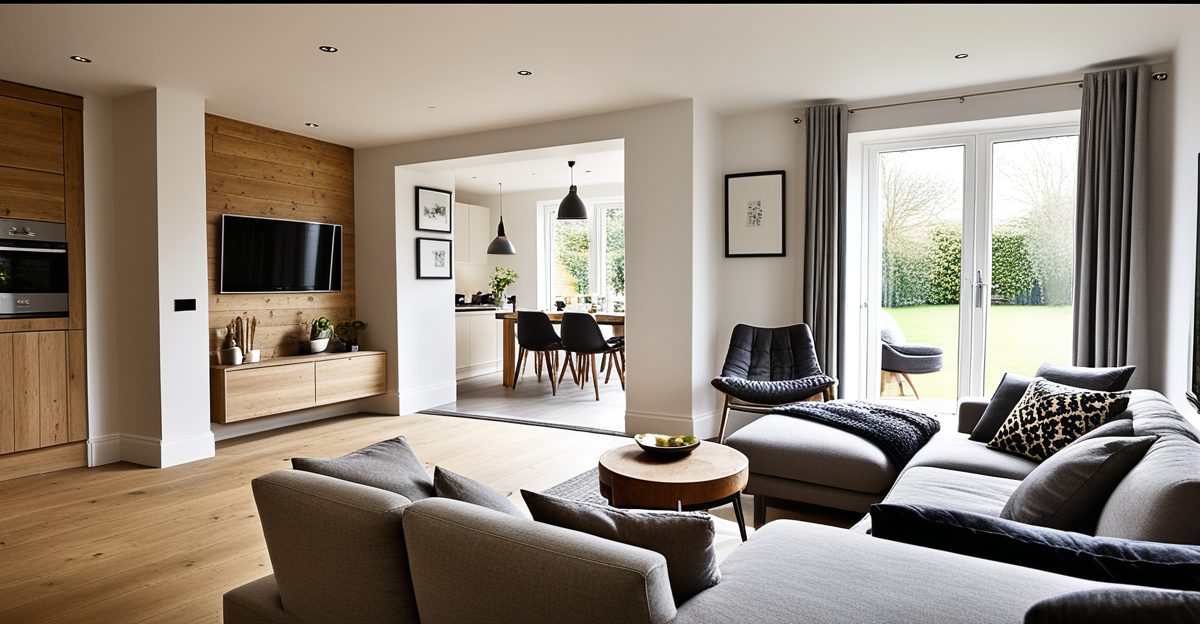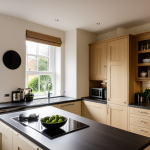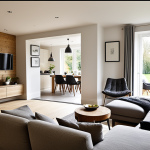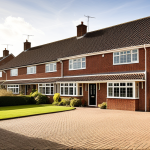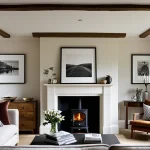Essential Strategies for Maximizing Natural Light in UK Homes
Maximizing natural light in UK homes relies heavily on strategic window placement, size, and style tailored to typical UK house layouts. Placing larger windows on south-facing walls captures the most sunlight, important in the often overcast UK climate. Incorporating multiple windows in one room can brighten home interiors by reducing shadowed corners.
Skylights and roof windows are effective solutions for common UK homes, such as terraced or semi-detached properties, where side window space is limited. These features channel daylight directly from above, significantly enhancing interior brightness without sacrificing privacy.
Have you seen this : How Can You Transform Small Spaces in UK Homes for Maximum Comfort?
Glass doors, especially sliding or French styles, serve as dual-purpose elements in many UK homes. They connect indoor and outdoor spaces, allowing light to flow unobstructed between rooms and patios. This openness can visually expand interiors while boosting the overall daylight levels.
Together, these methods provide a practical, design-driven approach to optimize natural light in UK homes. Properly implemented, they brighten home environments, reduce reliance on artificial lighting, and contribute positively to wellbeing, even when UK weather challenges light availability.
Additional reading : How can you seamlessly blend traditional and modern styles in a UK home?
Essential Strategies for Maximizing Natural Light in UK Homes
Maximizing natural light in UK homes involves thoughtful design choices, starting with window placement, size, and style. Positioning larger windows on south-facing walls boosts daylight intake, taking full advantage of the sun’s trajectory across the UK sky. Window styles like floor-to-ceiling panes or bay windows can also significantly brighten home interiors by increasing the glass surface area exposed to sunlight.
In common UK house layouts, incorporating skylights and roof windows offers excellent solutions to brighten home spaces that typically lack side windows, such as corridors or inner rooms. These overhead windows capture daylight that standard wall windows cannot, particularly useful given the UK’s often overcast weather.
To enhance room-to-room and indoor-outdoor brightness, selecting glass doors provides dual benefits: they allow light to penetrate deeper into the house and create visual continuity between spaces. Sliding or French doors with large glass panels are especially effective, improving both the aesthetic appeal and natural luminance.
By combining these essential strategies, homeowners can significantly improve daylight access and create an inviting atmosphere that capitalizes on the UK’s available natural light.
Affordable Tips to Increase Daylight Without Major Renovations
Finding low-cost daylight solutions to brighten home interiors is essential for many UK households. Simple interior adjustments can make a notable difference without the expense or hassle of major renovations.
One effective method to maximize daylight in UK homes is using light-colored paint with a satin or semi-gloss finish. These finishes reflect more light than matte options, helping to spread available sunlight deeper into rooms. Whites, creams, and pale pastels are ideal for amplifying natural brightness.
Incorporating mirrors and reflective surfaces strategically further enhances light distribution. Placing mirrors opposite windows or near light sources can bounce light into shadowed corners, creating a more open and airy feel. Reflective decor such as metallic frames or glass tabletops also contributes to this effect.
Furniture placement plays a practical role as well. Keeping bulky pieces away from window areas prevents obstruction of incoming light. Using low-profile or open-legged furniture allows light to flow underneath and around objects, maximizing the daylight that penetrates a room.
Together, these affordable techniques provide realistic, user-friendly options to improve natural illumination. Implementing these ideas can brighten home spaces effectively, boosting ambience and reducing dependence on artificial lighting.
Affordable Tips to Increase Daylight Without Major Renovations
Small, low-cost daylight solutions can significantly improve natural light in UK homes without the need for costly work. Choosing light, neutral paint colors with a satin or semi-gloss finish helps maximize daylight by enhancing surface reflectiveness. These finishes bounce light around a room, making it feel brighter and more open.
Strategically placing mirrors opposite windows or near sources of light can also amplify daylight. Reflective surfaces like glossy tiles or metallic accents serve the same purpose, distributing light effectively. This technique is especially useful in smaller or darker rooms where maximizing every ray matters.
Furniture arrangement is another practical way to brighten home interiors. Keeping bulky items away from windows prevents obstruction of incoming light. Opt for low-profile furniture that allows clear sightlines and easy light flow between spaces.
By using these simple, affordable tricks, homeowners can significantly boost indoor brightness. This supports well-being and reduces dependence on artificial lighting, aligning with the goal to maximize daylight in all parts of a typical UK home.
Essential Strategies for Maximizing Natural Light in UK Homes
Maximizing natural light in UK homes hinges on optimizing window placement, size, and style to effectively capture available sunlight. South-facing walls remain the prime location for larger windows, as they receive more direct light during the day, helping to maximize daylight even when the UK sky is overcast.
Window styles such as bay or floor-to-ceiling windows increase the glass surface area, allowing more sunlight to brighten home interiors. It’s essential to tailor these styles within typical UK house layouts, ensuring windows don’t compromise privacy or structural integrity.
In addition, skylights and roof windows are invaluable for rooms where wall space is limited—common in terraced or semi-detached UK homes. By directing light from above, these features bypass nearby buildings or trees that might otherwise block sunlight, significantly brightening often dim areas like corridors or internal rooms.
Selecting glass doors, like sliding or French doors, further enhances natural light by linking indoor spaces and outdoor areas seamlessly. Their expansive glass panels allow daylight to penetrate more deeply into homes, boosting overall daylight and creating a more open, inviting atmosphere.
Together, these strategies provide practical solutions to brighten home environments while making maximum use of the UK’s limited sunlight.
Adapting to UK Climate and Architectural Challenges
Maximizing natural light in UK homes requires adapting to the country’s often grey, overcast UK weather daylight conditions. Since sunlight can be limited, thoughtful design adjustments help harness all available daylight. Angling windows to the south and minimizing external shading elements direct the maximum light indoors even on cloudy days.
Traditional UK homes, including Victorian, Georgian, and other period properties, present unique daylight challenges due to deep floor plans and smaller, high-set windows. These homes benefit from solutions such as adding internal glass partitions or removing unnecessary walls to let daylight flow further inside. Roof lights and modestly sized skylights—common in renovations for period homes—effectively brighten dark corridors and inner rooms, which typically lack direct window access.
Real examples from UK home improvement projects show how these strategies bring noticeable daylight improvements. For instance, adding roof windows in a Victorian terrace dramatically transformed previously gloomy spaces. Similarly, using reflective interior finishes in Georgian homes helps spread light from limited window openings throughout the room.
By tailoring approaches to both the UK weather daylight and characteristic layouts of traditional homes, occupants can significantly brighten home interiors despite architectural and climatic constraints.
Essential Strategies for Maximizing Natural Light in UK Homes
Maximizing natural light in UK homes depends on precise window placement, size, and style to capture as much daylight as possible. South-facing windows optimize sunlight exposure throughout the day, crucial for homes dealing with the typical overcast UK climate. Larger windows with floor-to-ceiling designs or bay configurations increase the glass surface area, allowing more daylight to brighten home interiors effectively.
In many UK house layouts, especially terraced or semi-detached homes where side window space is limited, skylights and roof windows offer practical solutions. These features introduce daylight from above, noticeably enhancing brightness in internal or corridor spaces that otherwise remain dim, helping to maximize daylight efficiently.
Selecting glass doors, such as sliding or French styles, is another key strategy to brighten home interiors. Their wide glass panels facilitate light flow between rooms and connect indoor and outdoor spaces seamlessly. This not only improves natural light penetration but also creates an open, airy atmosphere. The transparent connection reduces shadowed areas, further contributing to brightening home environments. Together, these approaches form a robust framework to brighten home spaces and fully capitalize on natural light in UK settings.

